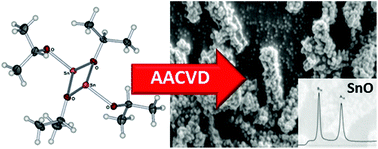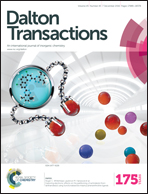Aerosol-assisted CVD of SnO from stannous alkoxide precursors†
Abstract
The stannous alkoxides [Sn(OR)2] [R = i-Pr, t-Bu, C(Et)Me2, CHPh2, CPh3] have been synthesised by reaction of Sn(NR′2)2 with two equivalents of HOR [R′ = Me, R = i-Pr; R′ = SiMe3, R = t-Bu, C(Et)Me2, CHPh2, CPh3]. Single crystal X-ray diffraction analysis of the bis(diphenylmethoxide) (4) and bis(triphenylmethoxide) (5) species have shown them to comprise three-coordinate Sn(II) centres through dimerisation in the solid state with the alkoxide units adopting transoid and cisoid configurations across the {Sn2O2} cores respectively. Thermogravimetric analysis indicates clean decomposition and some evidence of volatility at temperatures >200 °C for all three aliphatic alkoxides, whereas both the diphenyl- and triphenylmethoxide compounds provide higher decomposition temperatures and, for the triphenylmethoxide derivative, a residual mass consistent with the formation of a carbon-containing residue. The previously reported iso-propoxide (1) and tert-butoxide (2) derivatives have been utilised in toluene solution to deposit SnO thin films by aerosol-assisted chemical vapour deposition (AACVD) on glass at temperatures between 300 and 450 °C. While SnO is deposited under hot wall conditions as the only identifiable phase by p-XRD and Raman spectroscopy for both precursors, morphological analysis by SEM reveals inferior substrate coverage in comparison to previously reported ureide-based precursor systems.


 Please wait while we load your content...
Please wait while we load your content...